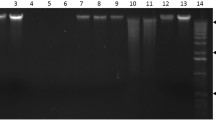Abstract
The implementation and generation of unbiased results from RNA-based techniques in functional genomic studies requires the isolation of high-quality RNA. In grapevines, the yield and quality of RNA can be significantly reduced by contaminants such as polyphenols, polysaccharides, and proteins, which are abundant during different stages of berry and leaf development. We describe an optimized cetyltrimethylammonium bromide (CTAB)-based RNA extraction protocol that allows effective extraction of high-quality total RNA from a wide range of grapevine tissues, including difficult organs such as symptomatic, pathogen-infected leaves and mature berries. Total RNA extracted with this protocol was successfully used for cDNA library construction as well as reverse transcription-polymerase chain reaction (RT-PCR) amplification. This protocol can also be easily scaled to accommodate different amounts of tissue.
Similar content being viewed by others
Abbreviations
- CTAB:
-
cetyltrimethylammonium bromide
- DEPC:
-
diethyl pyrocarbonate
- EtBr:
-
ethidium bromide
- PVP:
-
polyvinylpyrrolidone
- RT-PCR:
-
reverse transcription-polymerase chain reaction
References
Boss PK and Davies C (2001) Molecular biology of sugar and anthocyanin accumulation in grape berries. In: Roubelakis-Angelakis KA (ed.), Molecular Biology and Biotechnology of the Grapevine, pp. 1–33, Kluwer Academic Publishers, Netherlands.
Boss PK, Davies C, and Robinson SP (1996) Analysis of the expression of anthocyanin pathway genes in developingVitis vinifera L. cv Shiraz grape berries and the implications for pathway regulation. Plant Physiol 111: 1059–1066.
Bhalerao R, Keskitalo J, Sterky F, Erlandsson R, Bjorkbacka H, Birve SJ, Karlsson J, Gardestrom P, Gustafsson P, Lundeberg J, and Jansson S (2003) Gene expression in autumn leaves. Plant Physiol 131: 430–42.
Calaham A, Morgens P, and Walton E (1989) Isolation andin vitro translation of RNAs from developing peach fruit. Hortscience 24: 356–358.
Chang S, Puryear J, and Cairney J (1993) A simple and efficient method for isolating RNA from pine trees. Plant Mol Biol Rep 11: 113–116.
Chomczynski P and Sacchi N (1987) Single-step method of RNA isolation by acid guanidinium thiocyanate-pheno-chloroform extraction. Anal Biochem 162: 156–159.
Dellaporta SL, Wood J, and Hicks JB (1983) A plant DNA minipreparation: version II. Plant Mol Biol Rep 1: 19–21.
Doyle JJ and Doyle JL (1990) Isolation of plant DNA from fresh tissue. Focus 12: 13–15.
Fang G, Hammar S, and Rebecca R (1992) A quick and inexpensive method for removing polysaccharides from plant genomic DNA. Biotechniques 13: 52–56.
Franke KE and Adams DO (1995) Yield and quality of RNA from grape berries at different developmental stages. Am J Enol Vitic 46: 315–318.
Geuna F, Hartings H, and Scienza A (1998) A new method for rapid extraction of high quality RNA from recalcitrant tissues of grapevine. Plant Mol Biol Rep 16: 61–67.
Jakoola L, Pirttila AM, Halonen M, and Hohtola A (2001) Isolation of high quality RNA from Bilberry (Vaccinum myrtillus L.) fruit. Mol Biotechnol 19: 201–203.
Lay-Yee M, Della-Penna D, and Ross GS (1990) Changes in mRNA and protein during ripening in apple fruit (Malus domestica Borkh. Cv. Golden Delicious). Plant Physiol 94: 850–853.
Lers A, Khalchitski A, Lomaniec E, Burd S, and Green PJ (1998) Senescence-induced RNases in tomato. Plant Mol Biol 36: 439–449.
Lodhi MA, Ye G-N, Weeden NF, and Reisch BI (1994) A simple and efficient method for DNA extraction from grapevine cultivars andVitis species. Plant Mol Biol Rep 12: 6–13.
Loulakakis KA, Roubelakis-Angelakis KA, and Kanellis AK (1996) Isolation of functional RNA from grapevine tissues poor in nucleic acid content. Am J Vit Enol 47(2): 181–185.
Luo Y and Liu X (1994) Effects of ethylene on RNA metabolism in strawberry fruit after harvest. J Hortic Sci 69: 137–139.
Mazzara M and James DJ (2000) The influence of photoperiodic growth condition on isolation of RNA from strawberry (Fragaria x ananassa Duch.) tissue. Mol Biotechnol 15: 237–241.
Mejjad M, Vedel F, and Ducreux G (1994) Improvement of DNA preparation and of PCR cycling in RAPD analysis of marine microalgae. Plant Mol Biol Rep 12: 6–13.
Mullins MG, Bouquet A, and Williams LE (1998) Biology of the grapevine, pp 1–239, Cambridge University Press, Cambridge.
Newbury HJ and Possingham JV (1977) Factors affecting the extraction of intact ribonucleic acid from plant tissues containing interfering phenolic compounds. Plant Physiol 60: 543–547.
Ojeda H, Deloire A, Carbonneau A, Ageorges A, and Romieu C (1999) Berry development of grapevines: Relations between growth of berries and their DNA content indicate cell multiplication and enlargement. Vitis 38: 145–150.
Richards E, Reichardt M, and Rogers S (1994) Preparation of genomic DNA from plant tissue. In: Ausubel FM, Brent R, Kingston RE, Moore DD Seidman JG, Smith JA, and Struhl K (eds). Current protocols in Molecular Biology, pp 2.3.1–2.3.7, J. Wiley and Sons, New York.
Rodriques-Pousada R, Van Montagu M, and Van der Straeten D (1990) A protocol for preparation of total RNA from fruit. Technique 2: 292–294.
Tesniere C and Vayda ME (1991) Method for the isolation of high-quality RNA from grape berry tissues without contaminating interfering phenolics compounds. Plant Mol Biol Rep 9: 242–251.
Thomas P and Schiefelbein JW (2002) Improved method for purification of RNA from stem tissue of grapevine and its use in mRNA profiling. Am J Vit Enol 53: 231–234.
Sambrook J, Fritsch EF, and Maniatis T (1989) Molecular Cloning: A Laboratory Manual, 2nd ed. Cold Spring Harbor Press, Cold Spring Harbor, New York.
Wang CS and Vodkin LO (1994) Extraction of RNA from tissues containing high levels of procyanidins that bind RNA. Plant Mol Biol Rep 12: 132–145.
Winkel-Shirley B (2002) Biosynthesis of flavonoids and effects of stress. Curr Opin Plant Biol 5: 218–223.
Woodhead M, Taylor Ma, Davies HV, Brenna RM, and McNicol RJ (1997) Isolation of RNA from blackcurrant (Ribes nigrum L.) fruit. Mol Biotechnol 7: 1–4.
Author information
Authors and Affiliations
Corresponding author
Rights and permissions
About this article
Cite this article
Iandolino, A.B., Goes da Silva, F., Lim, H. et al. High-quality RNA, cDNA, and derived EST libraries from grapevine (Vitis vinifera L.). Plant Mol Biol Rep 22, 269–278 (2004). https://doi.org/10.1007/BF02773137
Published:
Issue Date:
DOI: https://doi.org/10.1007/BF02773137




